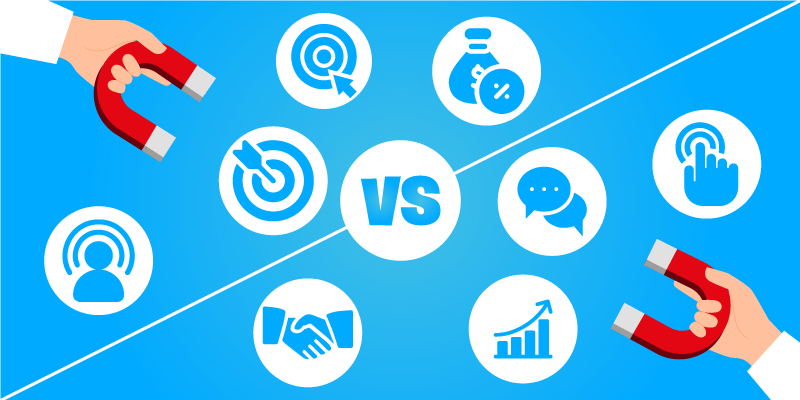Last updated on August 7th, 2023

What’s the best way to grow your SMB’s revenue? This guide offers insights on when to use lead generation and when to opt for demand generation marketing.
Generating awareness around a product or service can be multi-dimensional.
A perfect example is when we compare lead generation and demand generation marketing.
Knowing when to use either will make your marketing that much more effective.
So if you’re not gaining the buyer awareness and conversions your competitors are getting, read this guide to level the (marketing) playing field.
- What Is Lead Generation?
- What Is Demand Generation?
- What’s The Difference Between Lead Gen And Demand Gen?
- When Should SMBs Do Lead Generation Or Demand Generation?
- How To Create High-ROI Lead Gen And Demand Gen Campaigns In 5 Steps
- A Final Summary of Lead Generation Vs. Demand Generation

VipeCloud is the only Automation tool your small business needs to
be the hero to your customers.
With Email, Texting, Social, Suites, Chat, Stories, Video Email & Sign Up Forms fully built-in, we provide you with the perfect platform to grow your business.
15 Day Free Trial – Get started risk free. No CC needed.
What Is Lead Generation?
Lead generation is a direct way of turning a person, who may or may not yet be brand aware, to a prospect by collecting their contact information (name, phone, email, etc.) or scheduling a meeting.
Think of a company sharing their webinar – it acts as a lead generation machine:
1. A landing page is made to convert page visitors into webinar attendees.
2. During the webinar, the company offers value and asks attendees to take action on a product .
3. During post-webinar, this company can send marketing communications to the attendees who didn’t take action, moving them up the value ladder.
With lead generation, prospects typically gain something small in exchange for their information which ignites the value ladder process.
Turning eyeballs into leads simply means you’re offering something they consider buying in the future (so leads are in the consideration stage of the sales funnel).
From there, further marketing and sales turn them into paying customers.
What Is Demand Generation?
Demand generation is the strategy of creating buzz, conversation, and awareness of a product or service.
Think of a movie trailer.
Its role is to bring as much attention from movie-goers so that the movie gains attention and eventually generates revenue when out.
Demand generation involves focusing on a brand awareness aspect instead of converting impressions into paying customers altogether.
From a B2B or B2C perspective, demand gen is most handy when releasing a new product like a course, eBook, or product feature.
The demand can get people talking, creating more excitement, social proof, pre-orders, and eventual customers.
What’s The Difference Between Lead Gen And Demand Gen?
Here are some critical differences for SMBs to know when it comes to lead gen vs. demand gen:
- Lead generation is typically more measurable (a campaign offers X and Y number of people opted into it).
- Lead generation helps you nurture more direct customer relationships (especially with a CRM)
- Demand generation captures initial interest, while lead generation pushes someone into a sales cycle.
- Demand generation can build more trust in the long-term (ex., content marketing)
- Demand generation focused on educating your audience.
Examples of Lead Generation And Demand Generation
Here are different forms of lead and demand generation marketing (some may fall under both categories).
Lead Generation
- Lead gen ads
- Webinars
- SEO blogs
- SMS marketing
- Direct mail
- Social media posts
- Facebook parties
Demand Generation
- Content marketing videos
- Brand awareness ads
- Influencer marketing
- SMS marketing
- Blogs
- Podcasts
- PR campaigns
- Social media posts
When Should SMBs Do Lead Generation Or Demand Generation?
Most SMBs start with lead generation because it helps get revenue sooner and is easy to attribute.
However, there is overlap between generating leads and generating demand.
And to no surprise — you should be doing both.
For instance, let’s say a small business uses VipeCloud’s email marketing feature to send newsletters.
Some emails can be a mixture of content marketing (demand generation) about a topic their subscribers enjoy.
They can also have other emails with a call to action for a new product that only a particular portion of their audience will opt into.
In this example, both demand gen and lead gen are being leveraged with the use of VipeCloud.
How To Create High-ROI Lead Gen And Demand Gen Campaigns In 5 Steps
Here are 5 key steps to using both approaches optimally.
1. Know Your Audience
A fundamental understanding of who you’re marketing to makes doing so a much easier.
Knowing your market makes it easier to:
- Generate leads
- Offer product or service that benefits them
- Scale revenue
Here are several ways to research your audience so that your lead or demand generation campaigns speak to them:
- Market research using industry trends and customer reviews
- Client interviews
- Competitor research (who are they hyper-targeting in their ads, emails, and organic content)
- Creating an Ideal customer profile (ICP) using the information you’ve collected
- CRM data on current customers.
Your research should uncover the pain points and desires your market wants from a product or service.
2. Have A Product-market Fit
If what you’re offering doesn’t fit into what an audience subset wants, then your marketing won’t work.
Therefore, a product-market fit is essential to generate leads and holds a lesser, but important, role in demand generation.
You can pinpoint product-market fit in a couple of steps:
1. Use your research to learn your audience’s pain points and desires.
2. Establish your value proposition (how you’ll show value to your customers’ pain).
3. Creating a minimal viable product (MVP) that helps you test the validity of your value proposition.
4. Marketing your MVP, and tracking your numbers.
5. With a winning MVP, improve and refine it. With an unsuccessful MVP, go back to the drawing board and analyze what’s not working.
A product-market fit helps you scale faster, spend less on marketing, and boost customer retention.
But remember that your customers will come from a small portion of the market because only about 3% of your market is actively buying, 56% are not ready, and 40% are in between.
3. Pinpoint KPIs (Ideal Marketing Outcome)
Metrics back high-ROI marketing campaigns.
This means from the beginning, KPIs are set to ensure success.
In addition, you should make tweaks throughout to ensure the campaign meets its goal.
For that reason, tracking your numbers, no matter which form of marketing you’re doing, is pivotal.
For instance, if you’re using VipeCloud’s text message feature to market a service. Tracking opens, clicks, and so on will help you make better decisions on what to improve, remove, and so on.
Consider tracking key metrics like cost-per-acquisition, number of leads, and lead-to-appointment ratio for paid advertising.
If you’re bringing traffic to a lead capture page, look into your conversion rate, bounce rates, and traffic volume.
AND Don’t forget to set KPIs for sales as well.
Metrics like MQLs to SQLs, average sales cycle time, and win rates can help you see how your marketing is affecting sales.
One of the best ways to track your sales metrics is using a tool like VipeCloud Reports. These reports let you see your sales cycle from a birdseye view and team day-to-day activity.
4. Choose A Marketing Channel
Your market research will likely tell you the best marketing platform for your offer.
You can also adopt the ones mentioned earlier, whether you’re doing lead generation or demand generation.
Sticking to 2-3 platforms that get you the best results is best.
It’s about testing the optimal approach first and using data to pinpoint where your best impressions and conversions are coming from.
Many SMBs fall into the trap of thinking it’s the marketing vehicle that doesn’t work.
However, it could be how you’re approaching it.
For instance, say your cold emails have had low open rates for the past 2 months. It’s not that “email marketing no longer works,” but it could be that your subject lines need improvement.
5. Test New Marketing Approaches
Marketing is about constantly trying new approaches to see what works.
Sure some of your demand gen and lead gen approaches could be evergreen.
But innovating how you approach your market helps you stay ahead of competitors.
Testing comes in the form of trying different…
- CTAs
- Copywriting angles
- Offers
- Lead magnets
- Marketing platforms
Testing new approaches also give you new information you previously didn’t know. And with this new information, you may find success with your future campaigns faster.
A Final Summary of Lead Generation Vs. Demand Generation
Lead generation focuses on converting a target audience to take action on something.
While demand generation focuses on garnering an audience to increase brand recognition and converts people down the line.
No matter your approach, the key to successful campaigns is knowing and tracking your numbers.
And this doesn’t have to be complicated.
In fact, it’s a lot easier with a CRM like VipeCloud.
As the #1 CRM for small businesses, VipeCloud helps you track email and text message campaigns — as well as your sales numbers.
Want to see it in action?
You can request a demo to have a live walkthrough of the CRM.
And if you’d like to test VipeCloud for your marketing needs, you can do so on a 15-day free trial – no card required.

Leave a Reply